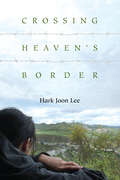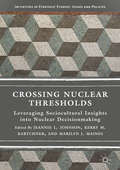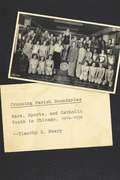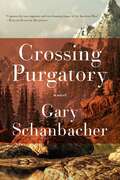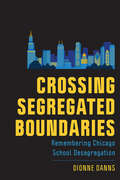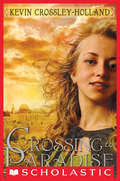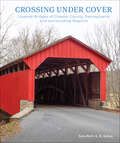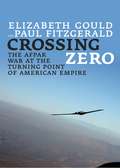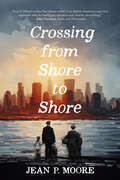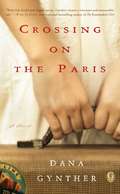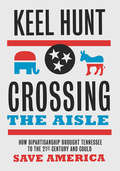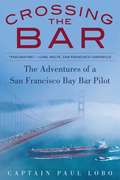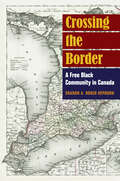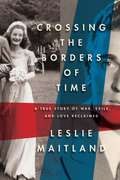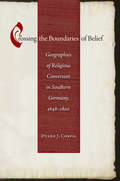- Table View
- List View
Crossing Heaven's Border
by Joon-Lee HarkFrom 2007 to 2011 South Korean filmmaker and newspaper reporter Hark Joon Lee lived among North Korean defectors in China, filming an award-winning documentary on their struggles. Crossing Heaven's Border is the firsthand account of his experiences there, where he witnessed human trafficking, the smuggling of illicit drugs by North Korean soldiers, and a rare successful escape from North Korea by sea. As Lee traces the often tragic lives of North Korean defectors who were willing to risk everything for their hopes, he journeys to Siberia in pursuit of hidden North Korean lumber mills; to Vietnam, where defectors make desperate charges into foreign embassies; and along the 10,000-kilometer escape route for defectors stretching from China to Laos and to Thailand.
Crossing Mandelbaum Gate: Coming of Age Between the Arabs and Israelis, 1956-1978
by Kai BirdPulitzer Prize winner Kai Bird&’s fascinating memoir of his early years spent in Israel, Jordan, Egypt, Saudi Arabia, and Lebanon provides an original and illuminating perspective into the Arab-Israeli conflict.In 1956, four-year-old Kai Bird, son of a charming American diplomat, moved to Jerusalem with his family. Kai could hear church bells and the Muslim call to prayer and watch as donkeys and camels competed with cars for space on the narrow streets. Each day on his way to school, Kai was driven through Mandelbaum Gate, where armed soldiers guarded the line separating Israeli-controlled West Jerusalem from Arab-controlled East. Bird would spend much of his life crossing such lines—as a child in Jerusalem, Saudi Arabia, and Egypt, and later, as a young man in Lebanon. In Crossing Mandelbaum Gate, a narrative that &“rips along like a spy novel&” (The New York Times Book Review), Bird&’s retelling of &“events such as Suez in 1956, the Six Day War of 1967, and Black September in 1970 are as clear and fresh as yesterday&” (The Spectator, UK). Bird vividly portrays emblematic figures like George Antonius, author of The Arab Awakening; Jordan&’s King Hussein; the Palestinian hijacker Leila Khaled; Salem bin Laden; Saudi King Faisal; President Nasser of Egypt; and Hillel Kook, the forgotten rescuer of more than 100,000 Jews during World War II. Bird, his parents sympathetic to Palestinian self-determination and his wife the daughter of two Holocaust survivors, has written a &“kaleidoscopic and captivating&” (Publishers Weekly) personal history of a troubled region and an indispensable addition to the literature on the modern Middle East.
Crossing Nuclear Thresholds: Leveraging Sociocultural Insights Into Nuclear Decisionmaking (Initiatives In Strategic Studies: Issues And Policies Ser.)
by Kerry M. Kartchner Jeannie L. Johnson Marilyn J. MainesThis book applies the cutting-edge socio-cultural model Cultural Topography Analytic Framework (CTAF) pioneered in the authors’ earlier volume Strategic Culture and Weapons of Mass Destruction: Culturally Based Insights into Comparative National Security Policymaking (Palgrave Macmillan, 2009) with an eye towards isolating those vectors of nuclear decision-making on which the US might exert influence within a foreign state. The case studies included in this volume tackle a number of the nuclear challenges—termed “nuclear thresholds”—likely to be faced by the US and identify the most promising points of leverage available to American policymakers in ameliorating a wide range of over-the-horizon nuclear challenges. Because near and medium-term nuclear thresholds are likely to involve both allies and adversaries simultaneously, meaning that US response will require strategies tailored to both the perception of threat experienced by the actors in question, the value the actors place on their relationship with the US, and the domestic context driving decision-making. This volume offers a nuanced look at each actor’s identity, national norms, values, and perceptual lens in order to offer culturally-focused insights into behavior and intentions.
Crossing Over Jordan
by Linda Beatrice BrownNovel about four generations of African American women, from the late 1800s to the 21st century.
Crossing Parish Boundaries: Race, Sports, and Catholic Youth in Chicago, 1914-1954 (Historical Studies of Urban America)
by Timothy B. NearyControversy erupted in spring 2001 when Chicago's mostly white Southside Catholic Conference youth sports league rejected the application of the predominantly black St. Sabina grade school. Fifty years after Brown v. Board of Education, interracialism seemed stubbornly unattainable, and the national spotlight once again turned to the history of racial conflict in Catholic parishes. It's widely understood that midcentury, working class, white ethnic Catholics were among the most virulent racists, but, as Crossing Parish Boundaries shows, that's not the whole story. In this book, Timothy B. Neary reveals the history of Bishop Bernard Sheil's Catholic Youth Organization (CYO), which brought together thousands of young people of all races and religions from Chicago's racially segregated neighborhoods to take part in sports and educational programming. Tens of thousands of boys and girls participated in basketball, track and field, and the most popular sport of all, boxing, which regularly filled Chicago Stadium with roaring crowds. The history of Bishop Sheil and the CYO shows a cosmopolitan version of American Catholicism, one that is usually overshadowed by accounts of white ethnic Catholics aggressively resisting the racial integration of their working-class neighborhoods. By telling the story of Catholic-sponsored interracial cooperation within Chicago, Crossing Parish Boundaries complicates our understanding of northern urban race relations in the mid-twentieth century.
Crossing Purgatory
by Gary SchanbacherIn the spring of 1858, Thompson Grey, a younger farmer, travels to his father''s estate seeking funds to expand his holdings. Far overstaying his visit, he returns home to find that his absence has contributed to a devastating family tragedy. Haunted by remorse, Thompson abandons his farm and begins a westward exile in the attempt to outpace his grief. During his wanderings, he encounters emigrants along the Santa Fe Trail who force him to assert his values and re-awaken his connection with humanity. Unwittingly, he finds himself at journey''s end in the one place where his strongest temptations are able to overtake him and once again put him to the test. Crossing Purgatory deals with questions of unprincipled ambition, guilt, and the price one man is willing to pay for atonement.
Crossing Segregated Boundaries: Remembering Chicago School Desegregation (New Directions in the History of Education)
by Dionne DannsScholars have long explored school desegregation through various lenses, examining policy, the role of the courts and federal government, resistance and backlash, and the fight to preserve Black schools. However, few studies have examined the group experiences of students within desegregated schools. Crossing Segregated Boundaries centers the experiences of over sixty graduates of the class of 1988 in three desegregated Chicago high schools. Chicago’s housing segregation and declining white enrollments severely curtailed the city’s school desegregation plan, and as a result desegregation options were academically stratified, providing limited opportunities for a chosen few while leaving the majority of students in segregated, underperforming schools. Nevertheless, desegregation did provide a transformative opportunity for those students involved. While desegregation was the external impetus that brought students together, the students themselves made integration possible, and many students found that the few years that they spent in these schools had a profound impact on broadening their understanding of different racial and ethnic groups. In very real ways, desegregated schools reduced racial isolation for those who took part.
Crossing Stones
by Helen FrostIn their own voices, four young people, Muriel, Frank, Emma, and Ollie, tell of their experiences during the first World War, as the boys enlist and are sent overseas, Emma finishes school, and Muriel fights for peace and women's suffrage.
Crossing Stones
by Helen FrostMaybe you won't rock a cradle, Muriel. Some women seem to prefer to rock the boat. Eighteen-year-old Muriel Jorgensen lives on one side of Crabapple Creek. Her family's closest friends, the Normans, live on the other. For as long as Muriel can remember, the families' lives have been intertwined, connected by the crossing stones that span the water. But now that Frank Norman—who Muriel is just beginning to think might be more than a friend—has enlisted to fight in World War I and her brother, Ollie, has lied about his age to join him, the future is uncertain. As Muriel tends to things at home with the help of Frank's sister, Emma, she becomes more and more fascinated by the women's suffrage movement, but she is surrounded by people who advise her to keep her opinions to herself. How can she find a way to care for those she loves while still remaining true to who she is? Written in beautifully structured verse, Crossing Stones captures nine months in the lives of two resilient families struggling to stay together and cross carefully, stone by stone, into a changing world.
Crossing To Paradise
by Kevin Crossley-HollandThe irresistible Gatty discovers that "Every step that you take on pilgrimage is a step toward paradise" in this gorgeously written adventure by master medieval chronicler Kevin Crossley-Holland.Gatty is a field girl on a manor. She has never seen busy London or the bright Channel, the snowy Alps of France or the boats in the Venetian sea. She has not sung in the Holy Sepulchre in Jerusalem or prayed at the manger in Bethlehem -- or been kidnapped, or abandoned, or kissed, or heartbroken. But all these things will change. As Gatty journeys with Lady Gwyneth and a prickly new family of pilgrims across Europe to the Holy Land, Kevin Crossley-Holland reveals a medieval world as rich and compelling as the world of today it foresees -- and, in Gatty, a character readers will never forget.
Crossing Under Cover: Covered Bridges of Chester County, Pennsylvania, and Surrounding Regions
by Sara Beth KohutCrossing under Cover is a lovingly crafted and detailed profiling of the 24 covered bridges located in the tricounty/state area of Chester County, Pennsylvania; Cecil County, Maryland; and New Castle County, Delaware. The book features • a general history of covered bridges, including Pennsylvania&’s prominence in that history; • an overview of covered bridge architectural styles; • a profile of each bridge, including photographs and interesting local facts; • the legacy and lore of each individual covered bridge and the impact they have on their communities and local history; • a map and detailed driving tour that readers can follow to visit all the bridges; and • the architectural style of each bridge. This is the only book to feature covered bridges of three contiguous states, and the latest book in decades to focus on covered bridges of Chester County.
Crossing Zero
by Paul Fitzgerald Elizabeth Gould"Fitzgerald and Gould do yeoman's labor in clearing the fog and laying bare American failures in Afghanistan."-Publishers Weekly, starred review of Invisible HistoryThe war in Afghanistan has become the most complex foreign policy problem the United States has ever faced, spreading into Pakistan and involving the conflicting interests of Russia, India, China and Iran. Written as a companion to Elizabeth Gould and Paul Fitzgerald's widely acclaimed book Invisible History: Afghanistan's Untold Story, Crossing Zero focuses on the nuances of the Obama administration's evolving military and political strategy, the people implementing it, and the long-term consequences for the United States and the region.
Crossing by Night
by David AaronShe was the young American wife of a stodgy British diplomat—a beautiful ornament to be displayed at important state functions. But Elizabeth Pack wanted more from life than formal consular gatherings and a loveless marriage. Dark clouds were gathering in the skies above Europe. An awesome German war machine was preparing to overrun the continent. And Elizabeth was ready and willing to do anything in her power to halt the Nazi juggernaut in its tracks... anything at all.
Crossing from Shore to Shore
by Jean P. MooreWhat happens when a love story turns into a political nightmare? From the moment Amalia enters his shop, the immigrant shoemaker Erasmo imagines she will fulfill his dream of America. And their story begins in promise. The lovers are passionate for life and each other, but they both come to see the truth beneath the surface. Amalia has opened Erasmo's eyes to inequality and the exploitation of the poor. Against the backdrop of the WWI Red Scare, while the Spanish Flu rages, Erasmo becomes embroiled in the battle between Italian anarchists and the federal government. The dream goes tragically wrong when Erasmo and his brother Giuseppe are framed for murder. The full story is revealed decades later when a great niece visits with the now elderly Amalia and begins piecing together the mystery her family wanted buried with the dead. Through three points of view, those of Amalia, the young Erasmo, and the great niece, the truth emerges: Only when the past is confronted will our ancestors stop whispering to us and finally be at peace.
Crossing on the Paris
by Dana GyntherThe opulent age of empires is ending, but the great queens of the sea-- the magnificent ocean liners--continue to reign supreme. Despite the tragedy of the Titanic, the race to build ever larger and more luxurious floating palaces continues, and passengers still flock to make the Atlantic crossing in style. In 1921,the SS Paris leaves Le Havre on her maiden voyage. Aboard, passengers dine in glittering grandeur on French cuisine, served by hundreds of unnoticed servants and chefs. Below the waterline, the modern oil-fired engines throb day and night. And for three women, this voyage will profoundly change their lives. Traveling first class, elderly Vera Sinclair is reluctantly moving back to Manhattan after thirty wonderful years abroad. In cozy second class, reveling in her brief freedom from family life, Constance Stone is returning after a failed mission to bring her errant sister home from France. And in the stifling servants' quarters, young Le Havre native Julie Vernet is testing her wings in her first job as she sets out to forge her own future. For all three, in different ways, this transatlantic voyage will be a life-changing journey of the heart.
Crossing the Aisle: How Bipartisanship Brought Tennessee to the Twenty-First Century and Could Save America
by Keel HuntThe latter third of the twentieth century was a time of fundamental political transition across the South as increasing numbers of voters began to choose Republican candidates over Democrats. Yet in the 1980s and '90s, reform-focused policymaking—from better schools to improved highways and health care—flourished in Tennessee. This was the work of moderate leaders from both parties who had a capacity to work together "across the aisle."The Tennessee story, as the Pulitzer Prize–winning author Jon Meacham observes in his foreword to this book, offers striking examples of bipartisan cooperation on many policy fronts—and a mode of governing that provides lessons for America in this frustrating era of partisan stalemate.
Crossing the Aisle: How Bipartisanship Brought Tennessee to the Twenty-First Century and Could Save America
by Keel HuntThe latter third of the twentieth century was a time of fundamental political transition across the South as increasing numbers of voters began to choose Republican candidates over Democrats. Yet in the 1980s and '90s, reform-focused policymaking—from better schools to improved highways and health care—flourished in Tennessee. This was the work of moderate leaders from both parties who had a capacity to work together "across the aisle." The Tennessee story, as the Pulitzer Prize–winning author Jon Meacham observes in his foreword to this book, offers striking examples of bipartisan cooperation on many policy fronts—and a mode of governing that provides lessons for America in this frustrating era of partisan stalemate. For more on Crossing the Aisle and author Keel Hunt, visit KeelHunt.com.
Crossing the Bar: The Adventures of a San Francisco Bay Bar Pilot
by Paul LoboThere is nothing placid about San Francisco Bay. Its raucous waters have hosted brutal storms, daring rescues, horrendous accidents, and countless hours of drama and tension. Captain Paul Lobo knows that better than most people. As a licensed harbor pilot in those treacherous waters, Lobo captained nearly 6,500 boats in a thirty-one year career-everything from mega-yachts to the USS Enterprise to the Love Boat. Each trip tells its own story, and Lobo shares many. Here readers will find gripping, tense adventure stories, all well told.Reading Crossing the Bar is like being on the rolling bridge with Lobo. Here are tragic deaths and lives saved, inspiring rescues, devastating storms, and the infamous and horrendous oil spill after the Cosco Busan rammed the Oakland Bay Bridge-which resulted in the first imprisonment of a maritime pilot for making an error.Readers will also find a December sea rescue Lobo assisted with in hurricane strength winds and monstrous seas. Without Lobo’s pilot boat and its crews’ supreme effort, the ship they saved would have foundered on the rocky Marin County, California, coastline with the loss of all hands.Skyhorse Publishing, as well as our Sports Publishing imprint, is proud to publish a broad range of books for readers interested in sports-books about baseball, pro football, college football, pro and college basketball, hockey, or soccer, we have a book about your sport or your team.In addition to books on popular team sports, we also publish books for a wide variety of athletes, including books on running, cycling, horseback riding, swimming, tennis, martial arts, golf, camping, hiking, aviation, boating, and so much more. While not every title we publish becomes a New York Times bestseller or a national bestseller, we are committed to publishing books on subjects that are sometimes overlooked by other publishers and to authors whose work might not otherwise find a home.
Crossing the Border: A Free Black Community in Canada
by Sharon A. HepburnHow formerly enslaved people found freedom and built community in Ontario In 1849, the Reverend William King and fifteen once-enslaved people he had inherited founded the Canadian settlement of Buxton on Ontario land set aside for sale to Blacks. Though initially opposed by some neighboring whites, Buxton grew into a 700-person agricultural community that supported three schools, four churches, a hotel, a lumber mill, and a post office. Sharon A. Roger Hepburn tells the story of the settlers from Buxton’s founding of through its first decades of existence. Buxton welcomed Black men, woman, and children from all backgrounds to live in a rural setting that offered benefits of urban life like social contact and collective security. Hepburn’s focus on social history takes readers inside the lives of the people who built Buxton and the hundreds of settlers drawn to the community by the chance to shape new lives in a country that had long represented freedom from enslavement.
Crossing the Border: On the Quadruple-Evidence Method
by Li Yang Shuxian YeThis book is the first monograph of its kind in the academic world which comprehensively expounds the new methodology of humanities. The quadruple-evidence method is one which integrates quadruple-evidences to open up new horizon for interpretation of ancient culture in the three-dimensional manner. The first layer of evidence refers to documents passed down from the past; the second layer of evidence refers to local written materials; the third layer of evidence includes oral legends of anthropology and folklore and etiquette in the living folk customs; the fourth layer of evidence refers to those ancient objects and images either unearthed in archaeological excavations or handed down from the past. The book consists of theoretical explorations and their applications in individual cases. While the first part studies the academic evolution, theory and methodological value of the quadruple-evidence method, the second part, in using the method in different cases, explores different historical and cultural phenomena in the history of China, attempting to extend the frontier of the origin of civilization from the approach of mythological study
Crossing the Borders of Time: A True Story of War, Exile, and Love Reclaimed
by Leslie MaitlandOn a pier in Marseille in 1942, with desperate refugees pressing to board one of the last ships to escape France before the Nazis choked off its ports, an 18-year-old German Jewish girl was pried from the arms of the Catholic Frenchman she loved and promised to marry. As the Lipari carried Janine and her family to Casablanca on the first leg of a perilous journey to safety in Cuba, she would read through her tears the farewell letter that Roland had slipped in her pocket: "Whatever the length of our separation, our love will survive it, because it depends on us alone. I give you my vow that whatever the time we must wait, you will be my wife. Never forget, never doubt." Five years later - her fierce desire to reunite with Roland first obstructed by war and then, in secret, by her father and brother - Janine would build a new life in New York with a dynamic American husband. That his obsession with Ayn Rand tormented their marriage was just one of the reasons she never ceased yearning to reclaim her lost love. Investigative reporter Leslie Maitland grew up enthralled by her mother's accounts of forbidden romance and harrowing flight from the Nazis. Her book is both a journalist's vivid depiction of a world at war and a daughter's pursuit of a haunting question: what had become of the handsome Frenchman whose picture her mother continued to treasure almost fifty years after they parted? It is a tale of memory that reporting made real and a story of undying love that crosses the borders of time.
Crossing the Boundaries of Belief: Geographies of Religious Conversion in Southern Germany, 1648-1800 (Studies in Early Modern German History)
by Duane J. CorpisIn early modern Germany, religious conversion was a profoundly social and political phenomenon rather than purely an act of private conscience. Because social norms and legal requirements demanded that every subject declare membership in one of the state-sanctioned Christian churches, the act of religious conversion regularly tested the geographical and political boundaries separating Catholics and Protestants. In a period when church and state cooperated to impose religious conformity, regulate confessional difference, and promote moral and social order, the choice to convert was seen as a disruptive act of disobedience. Investigating the tensions inherent in the creation of religious communities and the fashioning of religious identities in Germany after the Thirty Years' War, Duane Corpis examines the complex social interactions, political implications, and cultural meanings of conversion in this moment of German history.In Crossing the Boundaries of Belief, Corpis assesses how conversion destabilized the rigid political, social, and cultural boundaries that separated one Christian faith from another and that normally tied individuals to their local communities of belief. Those who changed their faiths directly challenged the efforts of ecclesiastical and secular authorities to use religious orthodoxy as a tool of social discipline and control. In its examination of religious conversion, this study thus offers a unique opportunity to explore how women and men questioned and redefined their relationships to local institutions of power and authority, including the parish clergy, the city government, and the family.
Crossing the Boundaries of Life: Günter Blobel and the Origins of Molecular Cell Biology (Convening Science: Discovery at the Marine Biological Laboratory)
by Karl S. MatlinA close look at Günter Blobel’s transformative contributions to molecular cell biology. The difficulty of reconciling chemical mechanisms with the functions of whole living systems has plagued biologists since the development of cell theory in the nineteenth century. As Karl S. Matlin argues in Crossing the Boundaries of Life, it is no coincidence that this longstanding knot of scientific inquiry was loosened most meaningfully by the work of a cell biologist, the Nobel laureate Günter Blobel. In 1975, using an experimental setup that did not contain any cells at all, Blobel was able to target newly made proteins to cell membrane vesicles, enabling him to theorize how proteins in the cell distribute spatially, an idea he called the signal hypothesis. Over the next twenty years, Blobel and other scientists were able to dissect this mechanism into its precise molecular details. For elaborating his signal concept into a process he termed membrane topogenesis—the idea that each protein in the cell is synthesized with an "address" that directs the protein to its correct destination within the cell—Blobel was awarded the Nobel Prize in Physiology or Medicine in 1999. Matlin argues that Blobel’s investigative strategy and its subsequent application addressed a fundamental unresolved dilemma that had bedeviled biology from its very beginning—the relationship between structure and function—allowing biology to achieve mechanistic molecular explanations of biological phenomena. Crossing the Boundaries of Life thus uses Blobel’s research and life story to shed light on the importance of cell biology for twentieth-century science, illustrating how it propelled the development of adjacent disciplines like biochemistry and molecular biology.
Crossing the Boundaries of Life: Günter Blobel and the Origins of Molecular Cell Biology (Convening Science: Discovery at the Marine Biological Laboratory)
by Karl S. MatlinA close look at Günter Blobel’s transformative contributions to molecular cell biology. The difficulty of reconciling chemical mechanisms with the functions of whole living systems has plagued biologists since the development of cell theory in the nineteenth century. As Karl S. Matlin argues in Crossing the Boundaries of Life, it is no coincidence that this longstanding knot of scientific inquiry was loosened most meaningfully by the work of a cell biologist, the Nobel laureate Günter Blobel. In 1975, using an experimental setup that did not contain any cells at all, Blobel was able to target newly made proteins to cell membrane vesicles, enabling him to theorize how proteins in the cell distribute spatially, an idea he called the signal hypothesis. Over the next twenty years, Blobel and other scientists were able to dissect this mechanism into its precise molecular details. For elaborating his signal concept into a process he termed membrane topogenesis—the idea that each protein in the cell is synthesized with an "address" that directs the protein to its correct destination within the cell—Blobel was awarded the Nobel Prize in Physiology or Medicine in 1999. Matlin argues that Blobel’s investigative strategy and its subsequent application addressed a fundamental unresolved dilemma that had bedeviled biology from its very beginning—the relationship between structure and function—allowing biology to achieve mechanistic molecular explanations of biological phenomena. Crossing the Boundaries of Life thus uses Blobel’s research and life story to shed light on the importance of cell biology for twentieth-century science, illustrating how it propelled the development of adjacent disciplines like biochemistry and molecular biology.
Crossing the Boundaries of Life: Günter Blobel and the Origins of Molecular Cell Biology (Convening Science: Discovery at the Marine Biological Laboratory)
by Karl S. MatlinA close look at Günter Blobel’s transformative contributions to molecular cell biology. The difficulty of reconciling chemical mechanisms with the functions of whole living systems has plagued biologists since the development of cell theory in the nineteenth century. As Karl S. Matlin argues in Crossing the Boundaries of Life, it is no coincidence that this longstanding knot of scientific inquiry was loosened most meaningfully by the work of a cell biologist, the Nobel laureate Günter Blobel. In 1975, using an experimental setup that did not contain any cells at all, Blobel was able to target newly made proteins to cell membrane vesicles, enabling him to theorize how proteins in the cell distribute spatially, an idea he called the signal hypothesis. Over the next twenty years, Blobel and other scientists were able to dissect this mechanism into its precise molecular details. For elaborating his signal concept into a process he termed membrane topogenesis—the idea that each protein in the cell is synthesized with an "address" that directs the protein to its correct destination within the cell—Blobel was awarded the Nobel Prize in Physiology or Medicine in 1999. Matlin argues that Blobel’s investigative strategy and its subsequent application addressed a fundamental unresolved dilemma that had bedeviled biology from its very beginning—the relationship between structure and function—allowing biology to achieve mechanistic molecular explanations of biological phenomena. Crossing the Boundaries of Life thus uses Blobel’s research and life story to shed light on the importance of cell biology for twentieth-century science, illustrating how it propelled the development of adjacent disciplines like biochemistry and molecular biology.
